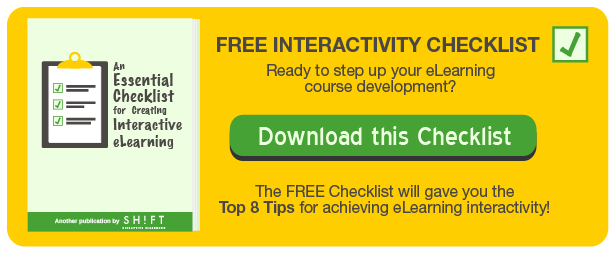If you want to create engaging courses you should start considering one main factor: relevance. This means creating compelling courses that speak directly to your audience.

The relevancy of a course should become obvious within the first five minutes by showing learners that it will address their concerns. The reason for this is that relevance plays a crucial role in cognition. When information is perceived as relevant, cognitive efforts significantly decrease, leading to much higher cognitive effects. In contrast, when facts and data have no relevance to a learner’s life, it makes it more difficult to form a connection in the mind. Caine and Caine (1991) explained it clearly: "the greater the extent to which what we learn is tied to personal, meaningful experiences, the greater and deeper our learning will be.”
Here are six ingredients that you might consider to help you build relevant eLearning courses that will get your learners actively engaged.
Always focus on creating clear course objectives:
Truth is people makes decisions based on what’s in their own best interest. This is the main motivator for their actions and that’s why training must be relevant and provide useful information. “What’s in it for me?” is what your learner wants to know. So, tell them why they should care and what you’ll be discussing in the course since the beginning. Give them reasons to continue.
Be Learner-Centric:
A learner-centric approach is a main pilar of effective eLearning courses. The first step to this approach is to understand the learners and their specific situation.
Here are a few tips to help you create learner-centric courses:
-
Adult learners want the maximum control possible over their learning process. For example, allow them to control their own pace and select the content they want to learn.
-
Give students choices and opportunities to make real-world decisions.
-
Add questions. Make learners reflect on how they can implement the knowledge they’ve just acquired.
Make your content actionable:
Adult learners invest time learning because they’re looking forward to get something useful out of it. They want something valuable not only in theory but also in practice. Offer them something practical and you’ll get their attention. They’ll appreciate it if they can apply what they learn at work or in their personal lives. They’re naturally attracted to valuable content..
Respect the audience:
Self-directed learners want to feel that they are in control. They want eLearning professionals to respect their independence and capability in making crucial learning decisions. They want you to recognize their ability to take responsibility for themselves..
Simple and appealing design:
eLearning courses that have an attractive and professional look are more credible and relevant to the learner. If your budget isn’t big or your design team is reduced, you can use authoring tools like SHIFT which provide a lot of ready-to-go templates, with a variety of designs and options, making it easy to rely on those for the design part of the course. What you want is elegant, fast and simple design.
Addressing motivation head on!
Lastly, there's the essential attribute of motivation, which should be built into the eLearning course design.Games can be incorporated into the structure of the course, in order to both encourage and engage the student. Research has shown that games do this very well, opening up the mind to instruction by forcing it to think about solutions. eLearning courses that incorporate the student/employee's interests into the structure are always more successful than their counterparts.
Do you have other success factors that make your eLearning courses relevant? Tell us about your experience.




